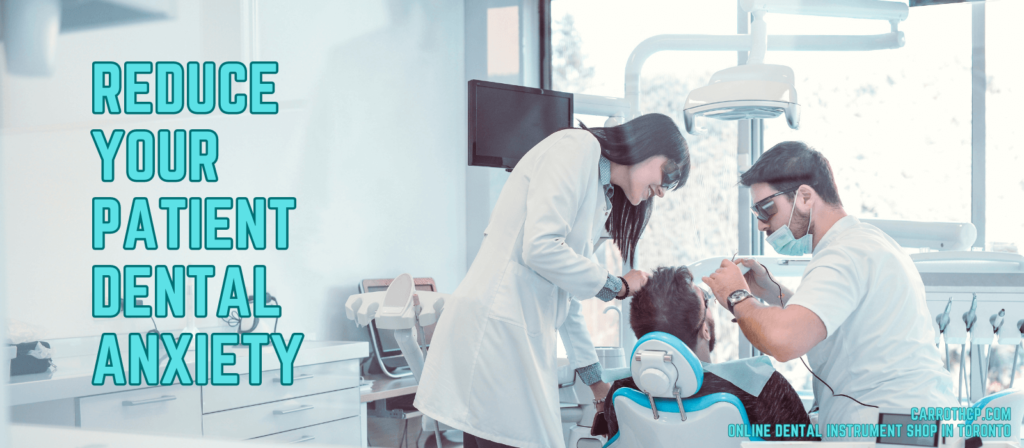
Table of Contents
Get Dental Catalogue PDF On Your Email
Key Factors in Managing Patients Dental Anxiety
Dental anxiety is a common condition that affects many individuals, leading to fear and apprehension surrounding dental visits. The good news is that there are key factors that dental professionals can implement to effectively manage and alleviate dental anxiety in patients. By understanding and addressing these factors, dental practices can create a more comfortable and stress-free environment for patients. In this article, we will explore the essential elements in managing dental anxiety and promoting positive dental experiences.
How common is dental anxiety?
Dental anxiety is more common than you might think. Studies have shown that approximately 9% to 15% of adults worldwide experience dental anxiety, moreover according to The Journal of the Canadian Dental Association about 22 percent of patients experience extreme fear or anxiety of seeing the dentist. , with varying levels of intensity. This anxiety can range from mild nervousness to severe fear and panic, often stemming from negative past experiences, fear of pain, or a general fear of dental procedures. Recognizing the prevalence of dental anxiety highlights the importance of addressing it effectively.
Can dental anxiety be genetic?
While dental anxiety can be influenced by various factors, including past experiences and learned behavior, there is evidence suggesting a genetic component as well. Studies have indicated that certain genetic variations may contribute to an increased susceptibility to dental anxiety. However, it is essential to note that genetics alone do not determine dental anxiety. Environmental factors, upbringing, and personal experiences also play significant roles. Understanding the potential genetic component can aid in tailoring anxiety management approaches to suit individual patients’ needs.
What to do if your patient has dental anxiety?

Building Trust and Communication
One of the most crucial factors in managing dental anxiety is establishing trust and open communication between the dentist and the patient. Dental professionals should take the time to listen to their patients’ concerns, answer questions, and explain procedures thoroughly. By demonstrating empathy and understanding, dentists can help alleviate anxiety and build a sense of trust with their patients. Open communication allows patients to express their fears and allows the dental team to tailor the treatment process accordingly.
Creating a Calm and Supportive Environment
The dental office environment plays a significant role in managing dental anxiety. Creating a calm and supportive atmosphere can help patients feel more at ease during their visits. Elements such as soothing music, comfortable seating, and pleasant aromas can contribute to a relaxed ambiance. The physical environment should be designed to minimize potential triggers of anxiety, such as dental tools or sterile smells. Additionally, friendly and empathetic staff members who provide emotional support can significantly impact patients’ experience.
Utilizing Behavior Management Techniques
Behavior management techniques can be highly effective in managing dental anxiety. Deep breathing exercises, progressive muscle relaxation, and guided imagery are some examples of techniques that can help patients relax and reduce anxiety during dental procedures. Dental professionals can guide patients through these techniques, teaching them how to use relaxation methods as coping mechanisms. By incorporating these techniques into the dental visit, patients can feel more in control of their anxiety.
Providing Education and Information
Knowledge is power, and providing patients with education and information about dental procedures can help alleviate anxiety. Dentists can explain the steps involved in a treatment plan, discuss the purpose and benefits of each procedure, and address common misconceptions or fears. By increasing patients’ understanding, dental professionals empower them to make informed decisions and feel more confident during their dental visits.
Considering Sedation Options
For patients with severe dental anxiety or phobia, sedation options can be considered. Sedation dentistry techniques, such as nitrous oxide (laughing gas), oral sedatives, or intravenous sedation, can help patients achieve a deep state of relaxation during dental procedures. These sedation options are administered under the supervision of a qualified professional and can significantly reduce anxiety levels. Dentists can evaluate each patient’s needs and determine the most appropriate sedation option based on their anxiety level and the complexity of the procedure.
Do You Know We Provide Best Dental Tools?
Get the best dental instruments anywhere in Ontario, feel free to visit our dental catalouge book!

